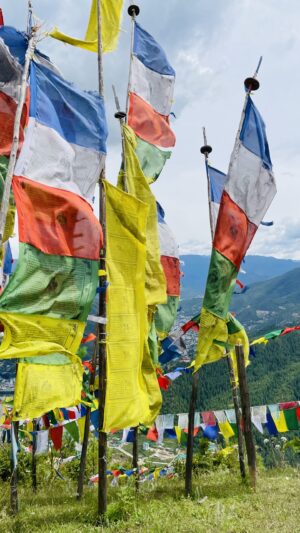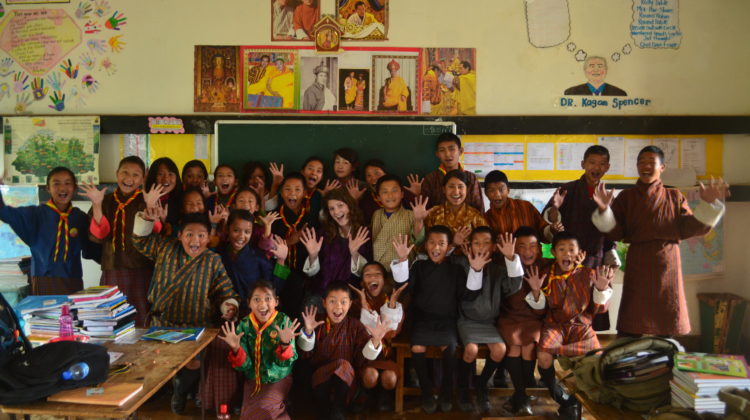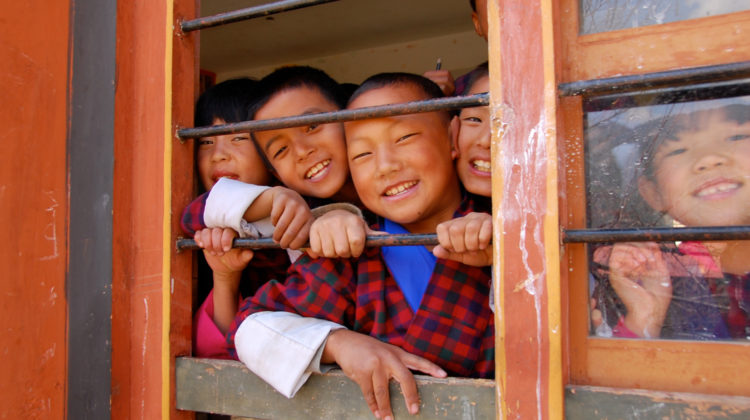School closures due to COVID-19 brought unparalleled disruptions to the education sector. Globally over 1.5 billion youth could no longer physically go to school.1 As countries faced outbreaks, almost overnight classrooms closed to prevent rapid local transmissions amid concerns of close quarters, shared spaces, and in some cases inadequate WASH (water, sanitation, and hygiene) infrastructure. Staying home became the new normal, forcing students to turn to alternative sources to continue their education.
Bhutan responded to COVID-19 through a whole of society and whole of government approach.2 The response plan focused on early detection, early reporting, early isolation and early treatment.3 Borders were closed on March 23 to limit the risk of the virus entering the country.4 The King’s relief fund, called Kidu, was issued to support citizens in need and give them the choice to stay home.5 Universal free healthcare and aggressive testing also helped prevent the spread and saw Bhutan lead the world with one of the highest testing rates per million.6
Bhutan’s quick and thorough response was also seen in the education sector. All schools in Bhutan closed on March 18 and resulted in 170,263 children from classes PP to XII out of school across the country.7 Youth, parents, and caregivers were suddenly picking up where their teachers left off.
Immediate response to school closures
To ensure the continuity of education, the Ministry of Education (MoE) implemented a national plan for Education in Emergency. An eLearning Programme was launched bringing teachers to television studios to broadcast lessons on BBS as a form of tele-education.8 Students and families would tune in daily on TV or radio to hear from their teachers at the scheduled time for their grade. The curriculum was also adapted and prioritized to deliver desired learning outcomes.9 In addition to the eLearning Programme, a variety of online tools were also used such as Google Classroom, etextbooks from the Royal Education Council, free access to eKuensel, free ebooks, and many more (see list of educational resources here).
Wellbeing a priority
Alongside tele-education and online learning resources were initiatives to support the wellbeing of youth during this difficult time. Psychological wellbeing is one of the nine domains within Bhutan’s development approach, Gross National Happiness, and was prioritized early in the response to COVID-19. A variety of organizations and institutions such as Sherig (MoE), National Council of Women and Children (NCWC), and local youth centers offered free counselling services. In addition to counselling, many youth organizations found ways to support youth who were facing increased stress and anxiety from the lockdown. They helped youth build healthy habits for overall wellbeing and connected them with peers to decrease isolation and bring social connection. https://web.archive.org/web/20210919072029if_/https://www.instagram.com/p/B_Bm9GlAzZW/embed/captioned/?cr=1&v=12&wp=540&rd=https%3A%2F%2Fbhutancanada.org&rp=%2Fbhutans-education-in-emergency%2F#%7B%22ci%22%3A0%2C%22os%22%3A43052.09999999404%7D
View this post on Instagram
A post shared by Young Girls’ Circle (@younggirlscircle_ygc) on Apr 15, 2020 at 7:33pm PDT
Reaching for equity in a time of crisis
Building on remote education and wellbeing initiatives, institutions and community organizations worked to mitigate the impacts of COVID-19 through an equity lens. For some children in Bhutan, access to online education is not reliable or possible in remote communities. Some households also do not have access to the internet or TV. In response to this, the MoE released the Self-Instructional Materials (SIM), an alternative print resource for youth who do not have access to internet, TV, or e-learning facilities.10 The theme of this initiative was ‘Reaching the Unreached’ and was intended to help 16,884 youth who did not have access to e-learning platforms.11 This gave students the opportunity to continue their education and was an effort to limit the impacts these students could face due to school closures.
For students who did have access to e-learning platforms, families now had to pay increased data plans in order to allow their children to use online resources, which became a financial burden for some households. To ensure the cost of data is not a barrier to students’ access to lessons, the MoE announced an initiative to provide 60% additional data for devices used by students.12 By increasing options and access to remote learning opportunities, students saw more opportunities to continue their education. https://web.archive.org/web/20210919072029if_/https://www.instagram.com/p/B_rJf30gJiQ/embed/?cr=1&v=12&wp=540&rd=https%3A%2F%2Fbhutancanada.org&rp=%2Fbhutans-education-in-emergency%2F#%7B%22ci%22%3A1%2C%22os%22%3A43059.29999999702%7D
View this post on Instagram
A post shared by Ministry of Education, Bhutan (@sherig.bhutan) on May 1, 2020 at 10:44pm PDT
Launch of Self-Instructional Material by the Ministry of Education
Special education needs
The COVID-19 school closures also affected the access and quality of special education needs (SEN). During this crisis, children with special needs require even more support and resources as they were without the aid of their teacher and the resources from their classroom. Some parents and caregivers do not have the time or training to facilitate learning for children with special needs.13 To support vulnerable youth, Ability Society Bhutan (ABS) continued early intervention services via home visits where it was safe.14 These services in early childhood education can have a transformative impact on children with special needs. Although limited, the SEN initiatives that are operating provide pathways for children with disabilities to learn and decrease the post-COVID gaps in education due to inequities.
Genedered lens
Another threat of COVID-19 schools closures is a potential to increase gendered gaps in education. While much of the world has not seen a crisis like this in many decades, there are lessons learned from the Ebola crisis in 2014. In places with extreme poverty, girls disproportionately faced increased dropout rates that lead to an increased rate of sexual exploitation, early pregnancy and forced marriage.15 Ebola hit some of the least developed countries where completion of education is already difficult, which is vastly different from the context in Bhutan. Still, there are local CSOs advocating to prevent the gendered impacts of COVID-19. NCWC and UNDP Bhutan released a campaign called #BeatCovidWithHer.16 This campaign aimed to protect women facing gender based violence and to increase awareness of the unequal share of domestic responsibilities. Young girls may have limited time to focus on their studies due to increasing domestic and caring responsibilities. In worsening economics they may even have to drop out to support the family to generate income.17 The gendered impacts of school closures would need to be studied further, but the work of this campaign shows a commitment to look at the impact of this pandemic through a gendered lens. https://web.archive.org/web/20210919072029if_/https://www.instagram.com/p/B_zJdIFgJts/embed/captioned/?cr=1&v=12&wp=540&rd=https%3A%2F%2Fbhutancanada.org&rp=%2Fbhutans-education-in-emergency%2F#%7B%22ci%22%3A2%2C%22os%22%3A43064%7D
View this post on Instagram
A post shared by UNDP Bhutan (@undp_in_bhutan) on May 5, 2020 at 1:17am PDT
Post-COVID lessons
As the world continues to face a global pandemic it is too early to know the extent that inequities will be affected by COVID-19. In Bhutan the response by government institutions and CSOs was a reflective effort to support and advocate for youth who had less opportunities to continue their education due to location, class, ability, or gender. This focus on equity has the potential to mitigate the impact recent school closures will have on the most vulnerable youth. As the government in Bhutan discusses reopening schools,18 the lessons learned from this emergency can inform a post-COVID education system and help Bhutan continue to move toward its aspirations for more equity and inclusion.
Footnotes
1 Devercelli, Amanda. “Supporting the youngest learners and their families in the COVID-19 (coronavirus) response.” World Bank Blogs. 16 April 2020. https://blogs.worldbank.org/education/supporting-youngest-learners-and-their-families-covid-19-coronavirus-response
2 Ministry of Health. “Bhutan’s Response to COVID-19 Pandemic: WHO information sharing session.” Royal Government of Bhutan. 20 April 2020. https://apps.who.int/gb/COVID-19/pdf_files/30_04/Bhutan.pdf
3 Ministry of Health.
4 Rai, Rajesh. “Border gates to close from today.” Kuensel. 23 March 2020. https://kuenselonline.com/border-gates-to-close-from-today/
5 Office of the Prime Minister and Cabinet. “Prime Minister Announces Druk Gyalpo’s Relief Kidu Program.” Royal Government of Bhutan. 14 April 2020. https://www.cabinet.gov.bt/prime-minister-launches-the-druk-gyalpos-relief-kidu-program/
6 “Bhutan has one of world’s highest testing rate.” South Asia Monitor. 30 April 2020. https://southasiamonitor.org/bhutan/bhutan-has-one-worlds-highest-testing-rates
7 Pelden, Sonam. “UNICEF: Urgent need to secure learning for children across South Asia. UNICEF. 9 April 2020. https://www.unicef.org/bhutan/press-releases/unicef-urgent-need-secure-learning-children-across-south-asia
8 Wangchuk, Jigme. “Tele-education in the wake of Covid-19 threat.” Kuensel. 26 March 2020. https://kuenselonline.com/tele-education-in-the-wake-of-covid-19-threat/
9 Ministry of Education. Guidelines for Curriculum Implementation Plan for Education in Emergency (EIE). Royal Government of Bhutan. 20 March 2020. http://www.education.gov.bt/wp-content/uploads/2020/03/Guidelines-for-Curriculum-Implementation-Plan-for-Education-in-EmergencyEiE.pdf
10 Ministry of Education. “Launch of Self-Instructional Materials.” Royal Government of Bhutan. May 2020. http://www.education.gov.bt/index.php/launch-of-self-instructional-materials-2/
11 Ministry of Education. “Launch of Self-Instructional Materials.” Royal Government of Bhutan. May 2020. http://www.education.gov.bt/index.php/launch-of-self-instructional-materials-2/
12 Ministry of Education. “Notification on Education Data Plan”. Royal Government of Bhutan. 10 May 2020. http://www.education.gov.bt/wp-content/uploads/2020/05/Notification-on-Education-Data-Plan.pdf
13 Hill, Faith. “The Pandemic is a Crisis for Students with Special Needs.” The Atlantic. 18 April 2020. https://www.theatlantic.com/education/archive/2020/04/special-education-goes-remote-covid-19-pandemic/610231/
14 Ability Bhutan Society. “Home Visits.” Ability Bhutan Society. May 2020. http://absbhutan.org/home-visits/
15 Giannani, Stephani. “Covdi-19 school closures around the world will hit girls hardest.” Unesco. 31 March 2020. https://en.unesco.org/news/covid-19-school-closures-around-world-will-hit-girls-hardest
16 National Council for Women and Children. “Notifications: #BeatCovidWithHer.” Royal Government of Bhutan. 30 April 2020. https://www.ncwc.gov.bt/notifications/399
17 Giannani.
18 Drukpa, Usha, “Govt yet to decide on school reopening: Education Minister.” The Bhutanese. 16 May 2020. https://thebhutanese.bt/govt-yet-to-decide-on-school-reopening-education-minister/
Bhutan’s Education in Emergency: reaching for equity in a time of crisis







